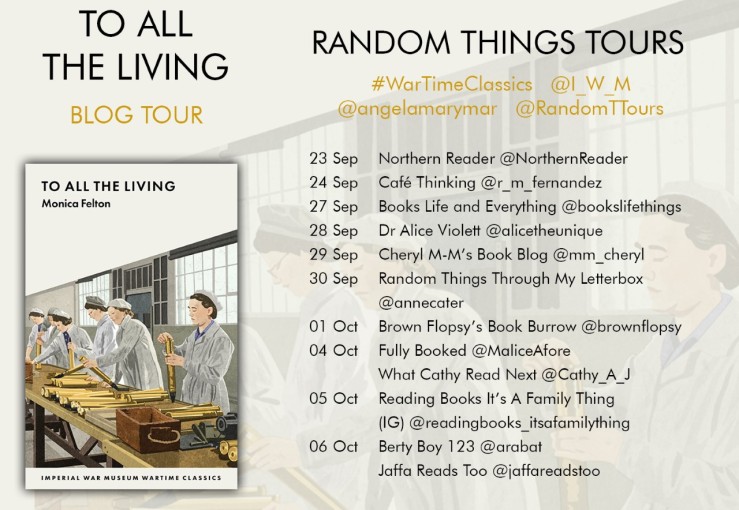
Welcome to today’s stop on the blog tour for To All the Living by Monica Felton. My thanks to Anne at Random Things Tours for inviting me to take part in the tour and to the Imperial War Museum for my review copy. Do check out the posts by the book bloggers who have already hosted stops on the tour.
 About the Book
About the Book
In January 1941 Griselda Green arrives at Blimpton, a place ‘so far from anywhere as to be, for all practical purposes, nowhere.’
Monica Felton’s 1945 novel gives a lively account of the experiences of a group of men and women working in a munitions factory during the Second World War.
Wide-ranging in the themes it touches on, including class, sexism, socialism, and wartime bureaucracy, the novel is vivid in its portrayal of factory life and details the challenges, triumphs and tragedies of a diverse list of characters.
Format: Paperback (412 pages) Publisher: Imperial War Museum
Publication date: 23rd September 2021 [1945] Genre: Fiction, Modern Classics
Purchase links
Publisher | Hive
Links provided for convenience only, not as part of an affiliate programme
My Review
I’ve read quite a few of the previous books in the Imperial War Museum’s Wartime Classics series, including Eight Hours From England, Patrol, Green Hands, Pathfinders and Sword of Bone. To All the Living, drawing on the author’s own wartime experiences at the Ministry of Supply, is the latest in the series which is aimed at bringing previously out of print novels about the Second World War back into the hands of readers.
To All the Living is packed full of detail about the minutiae of the daily organisation of the Blimpton munitions factory although there is less detail about the actual work the women carry out. Blimpton itself is a sprawling complex whose various buildings, some partially underground, are described as ‘looking like mounds of earth with a door cut in, like huge communal graves newly thrown up and not yet ready for the stone-mason’. Prophetic, as it turns out.
The book has a large cast of characters, some of whom are brought to life by Monica Felton’s observant and often unsparing pen pictures, such as Miss Creed, Chief Women Labour Officer, ‘a large faded blonde who might have been described as overblown had it not been so obvious that she had never flowered’. Or Senior Labour Manager, Captain Knowles, who ‘had a special way of laughing; a way that seemed to imply that anyone who thought his observation intended to be funny would be convicted of weak judgment and frivolous outlook’.
A satirical edge is introduced through the naming of some of the characters. For example, Lord Outrage, the Minister for Weapons Production, or Otway Dolphin, a Public Relations Officer for a factory whose operations must remain a secret. Or the aforementioned Captain Knowles’ proud boast about having been previously employed by a company named EELS (which we learn stands for Empire Exploitations Ltd.) I also enjoyed the author’s humorous descriptions and pointed asides that draw attention to the pomposity of various characters and the meaningless bureaucracy that absorbs so much of the management’s time.
The book’s cast of characters reflect the mass of people from all classes and backgrounds who found themselves working together at munitions factories like the fictional Blimpton during World War Two. Although having a common purpose, not everything at Blimpton is harmonious.
One of the issues Monica Felton explores in the book is the shortage of labour, especially of women workers. This is hardly surprising given the workers are often billeted in less than ideal accommodation, the work is potentially dangerous and frequently monotonous in nature. As one character remarks, ‘This isn’t a holiday camp’. The petty rules and restrictions, and the remote location of the factory add to the difficulties. This is exemplified by the experiences of new recruit, Griselda Green, who arrives at Blimpton Halt railway station to find there seems to be no transport laid on to reach the factory.
It has to be said the management of the factory, especially Mr Brown the factory’s Superintendent, don’t come out too well being depicted as ineffective, overly bureaucratic and averse to change. The exception is Assistant Superintendent Dan Morgan, whose efforts to improve efficiency and conditions for the workers are met with a lack of enthusiasm, even resistance. He comes across as a lone voice of reason, for instance when other members of the factory management seek to blame their failure to reach output targets on the poor quality of labour. He protests, ‘People are what you make them. The finest people on earth can’t travel twelve miles to work every day when there isn’t any transport’.
I’m afraid I must beg to differ with Alan Jeffreys in his introduction to the book in which he argues that To All the Living is more readable than other similar books such as Inez Holden’s Night Shift and There’s No Story There (both published by Handheld Press). Having read both of those books, I found them preferable to To All the Living which at 412 pages (not 312 pages as stated on the IWM’s online shop) requires quite an investment of time. Having said that, there are occasional passages of evocative description in which the writing really came alive for me, such as the following depicting those coming off the afternoon shift.
‘The spring evenings were clear and sharp, like winter. When the night-shift workers entered the factory, at a quarter to ten, a thin rim of dusk still hung around the sky, but when the afternoon-shift left, half an hour later, it was dark. Torches flashed on and off down the clean-ways. The shifting-houses were crowded… They jostled and shouted, flinging off their uniforms, hastily fastening the belts and buttons, the hooks and zippers of their own clothes, and then rushed out to reclaim their contraband at the entrance to the Danger Areas and to scramble to the buses that would take them to the Main Gates of the factory. Outside the gates the rush was intensified… Voices rose and fell, monosyllabic, tired; in the dark they seemed to come from nowhere; they were like the voices of England, all gathered together in one place: lively cockney voices, breaking into shrillness; the slow cold tones of the midlands, flat and unaccented; the singing voices of Wales, and the chipped, rough accents of Lancashire; soft, blurred country voices from twenty counties mingled into the chatter, the laughter, the sudden brief screams of townspeople lost in the darkness, homeless, fierce in their desire for rest and warmth and comfort.’
Although I may have enjoyed other books in the Wartime Classics series more, To All the Living certainly provides an insight into an often overlooked part of the war effort and highlights how much of a contribution to that effort was made by women.
In three words: Authentic, detailed, acutely-observed
Try something similar: There’s No Story There by Inez Holden
 About the Author
About the Author
Monica Felton (1906–1970) was a feminist, socialist, peace activist and a pioneering proponent of town planning. She went to University College, Southampton and then did a Phd at the LSE. in 1937 she was elected a member of the London County Council representing St Pancras South West. During the Second World War she served in the Ministry of Supply, an experience she reflected in To All the Living. In 1942 she became a Clerk of the House of Commons.
After the war she became involved in town planning, serving as Chair for the Peterlee and Stevenage Development Corporations. However, she was fired from the post after taking an unauthorized trip to North Korea on behalf of the Women’s International Democratic Federation in 1951. On her return from this trip she accused American troops of atrocities and British complicity. There was a media and establishment backlash and even accusations of treason. As a result she became increasingly isolated in Britain and moved to India in 1956. She died in Madras (modern day Chennai) in 1970.





This does sound fascinating… as do some of the others!
LikeLike
Thanks for the blog tour support x
LikeLike